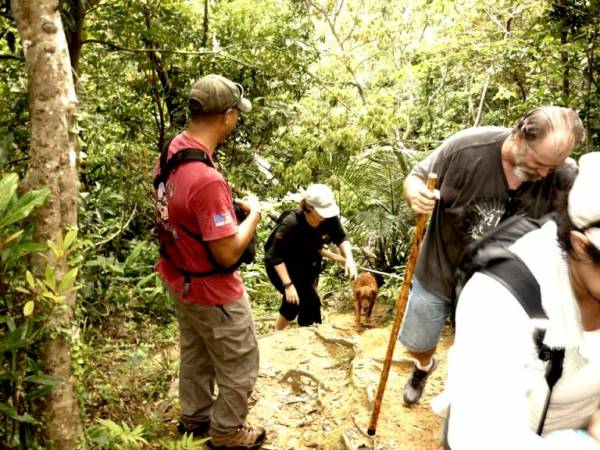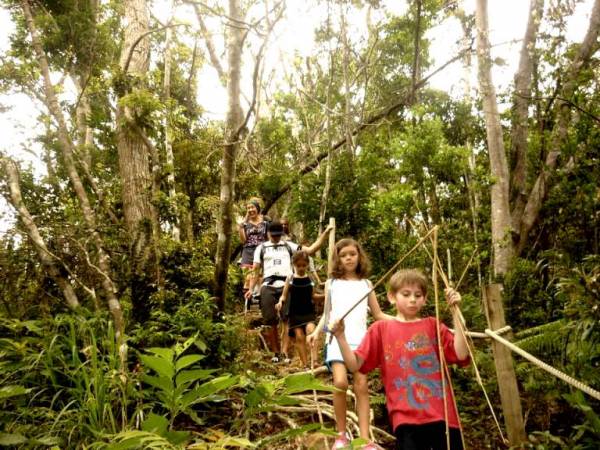One of my regular activities involves Saturday morning trail runs with other women. We belong to a group called WOOT (Women on Okinawa Trails), and we enjoy breaking up the monotony of weekday pavement runs by taking to the trails. Last summer, we realized that hiking the trails would open up opportunities to encourage less active family members and friends to get moving.
One of my regular activities involves Saturday morning trail runs with other women. We belong to a group called WOOT (Women on Okinawa Trails), and we enjoy breaking up the monotony of weekday pavement runs by taking to the trails. Last summer, we realized that hiking the trails would open up opportunities to encourage less active family members and friends to get moving.
We’re Not Moving Around Enough
According to the Centers for Disease Control and Prevention, statistics published in 2013 suggest that 60% of American adults do not get the recommended amount of physical activity.
Furthermore, the University of Rochester Medical Center published in its Health Encyclopedia that 50% of adolescents do not get enough physical activity and on average they spend 7.5 hours a day on TV, computers, games, and cell phones.
What these statistics imply is that an equally high number of Americans will invariably suffer from various health problems as a result of inactivity.
The American Heart Association recommends at least thirty minutes of moderate-intensity aerobic activity at least five days a week for overall cardiovascular health, and moderate-to-high-intensity muscle strengthening activity at least two days a week for additional health benefits.
For children (six to seventeen years), the duration of aerobic activity should be sixty minutes a day, and muscle strengthening activities are encouraged at least three days a week.
For some, finding time to exercise is legitimately difficult. But let’s face it, most people choose not to exercise because they favor other types of activities.
Maybe the key to getting people moving is to stop showing them all the reasons why they should exercise, and show them instead some physical activity options that might actually appeal to them.
The Reason to Choose Hiking
Hiking is a physical activity that may potentially appeal to a large and diverse group of people. It’s a physical activity that does not require a certain level of fitness, a certain skill set, or expensive clothes and gear.
All that’s needed is a decent pair of hiking shoes and maybe a hydration pack or a hand-held water bottle. Obviously, those who venture into more adventurous forms of hiking will want to invest in additional and more quality shoes and gear, but for the beginner hiker none of these extras are necessary.

Some of you may be asking at this point how hiking is any different to walking, and if walking seems like a pretty boring activity, then why would hiking be any different?
Besides the obvious answer that you’re expecting – that you get to appreciate the beauty of nature and the outdoors – hiking can be an activity that everyone in the family is able to participate in, hence it makes for a great family day out, or on a larger scale, a family and friends group event.
One way that our trail running group has attempted to turn hiking into a fun family and group activity is by advertising it as more of a social versus sporting event.
We encourage friends to bring their friends, and our kids’ friends to bring their friends, and so forth. For the young ones, we try to make the event enjoyable by providing “nature hunt” challenges and offering prizes.
The kids get so caught up in finding answers to clues along the trails that they forget they are even exercising. Likewise, the adults are typically so engaged in conversation that their fluctuating levels of exertion often go unnoticed.
The Benefits of Hiking
But on a more serious note, hiking provides some great benefits for adults and youth alike. First of all, hiking is a low-impact activity and therefore ideal for beginner exercisers, or individuals who are younger, older, overweight, or who suffer from arthritis or osteoporosis.
Such individuals can enjoy the fun aspects of hiking while also reaping the following benefits:
- Weight loss, especially when uphill hiking is involved. The number of calories burned during uphill hiking is comparable to that of jogging.
- Improved cardiovascular fitness, which is important because it elevates your heart rate, which in turn strengthens your heart and blood vessels.
- Improved muscle tone, especially if the course is quite vigorous and causes your legs to work harder.
- Healthier bone structure, due to the pressure that hiking places on the bones.
- Greater mental clarity, as hiking activates awareness in all of your senses, but especially your eyes and ears.
- Reduced stress and general feeling of fulfillment. Any type of exercise, hiking included, helps to relieve stress and lead to feelings of fulfillment and overall better mental health.

In a day and age where technology has greatly increased the number of entertainment options and broadened our work capabilities but also lengthened our working days, adults and youth need to be enticed to work out.
If you live near some trails and have the opportunity to organize a hiking event, I encourage you to do so and then invite as many friends and family members as possible.
Remember, hiking can be as easy or as difficult as you like. Start with short, easy routes and build up to longer hikes over increasingly difficult terrain. And most important of all is keeping it fun!
References:
1. US Dept. of Health and Human Services, Center for Disease Control and Prevention, “Physical Activity and Health: A Report of the Surgeon General Executive Summary.” Accessed May 7, 2014.
2. University of Rochester Medical Center. “Exercise Goals for Kids.” Accessed May 7, 2014.






